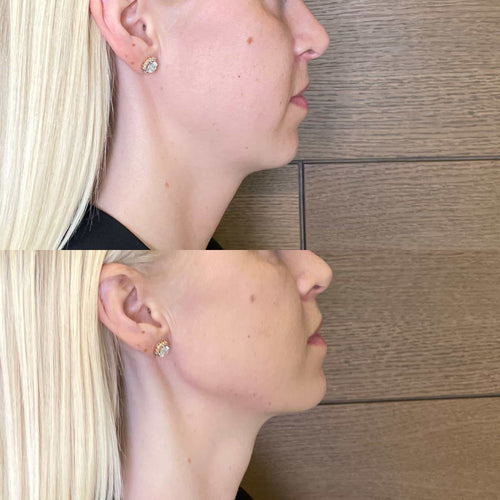Schedule a Dermal Filler Session with Dr. Laura Geige
## Anatomical Function
Anatomically, flaring your nostrils, also known as nasolabial reflex, is a natural physiological response triggered by various stimuli.
Here’s how it works:
Book a Dermal Filler Appointment at It’s Me and You Clinic with Dr. Laura Geige
- Stimuli: The primary trigger for nostril flaring is the need to increase airflow into the nasal passages. This can be caused by:
- Deep breathing
- Exercise
- Exertion
- Allergic reactions
- Cold air inhalation
- Strong odors
- Muscle Action: When stimulated, the muscles responsible for controlling the nostrils (the dilator naris muscle) contract.
- Mechanism: The contraction of these muscles widens the nasal openings, effectively increasing the surface area available for air to enter.
The degree and frequency of nostril flaring varies significantly between individuals. Some people may flare their nostrils subtly during exercise, while others may exhibit more pronounced flaring when experiencing intense physical exertion or allergic reactions.
Therefore, it’s difficult to quantify how “common” nostril flaring is, as its prevalence depends on various factors, including individual physiology and environmental stimuli. However, it’s a normal physiological response in most people.
Nasal Constriction
Physiological Reasons
The Role of Scent
## Cultural Significance
Scent plays a fascinating and complex role in human culture, deeply intertwined with language, memory, and social interactions.
While we often consider language primarily as a system of spoken or written words, scent acts as a powerful, nonverbal communication channel that complements and sometimes even overrides verbal cues.
Different cultures have developed unique olfactory landscapes, associating specific scents with emotions, memories, rituals, and social status.
In some societies, incense is burned during religious ceremonies or to purify spaces, its aromatic smoke carrying symbolic meaning and invoking a sense of the sacred.
Similarly, perfumes and fragrances are often used to signal identity, attractiveness, or even social group membership.
Certain scents can evoke powerful memories and trigger emotional responses that transcend language barriers. The smell of freshly baked bread might bring to mind childhood comfort, while the scent of a particular flower could transport someone back to a romantic encounter.
The cultural significance of scent is further demonstrated in cuisine. Different cultures have distinct culinary traditions that rely on specific spices and aromas to create unique flavor profiles and evoke cultural identity.
Consider the pungent aroma of Indian curry or the delicate fragrance of Japanese green tea – each scent carries a story and a connection to a particular culture’s history and values.
While the act of flaring nostrils might seem insignificant, it can be interpreted as an involuntary response to a strong scent, perhaps indicating interest, disgust, or even arousal.
Cultural norms surrounding scent perception and expression vary widely. Some cultures embrace strong scents as a sign of vitality and richness, while others prefer more subtle aromas.
Understanding the cultural context of scent is crucial for navigating social interactions and appreciating the diverse ways in which humans experience and communicate through olfaction.
Flaring in Non-Human Animals

Communication and Expression in Humans
Psychological Impact
## Factors Influencing Flare Frequency
Flaring nostrils, also known as *nasal flaring*, is a common physiological response that occurs when individuals are experiencing increased respiratory effort. This can happen during various activities, such as exercise, breathing in cold air, or even moments of heightened stress or emotion.
While typically benign, the frequency of nasal flaring can be influenced by several psychological and physical factors. Understanding these factors can provide insights into why some individuals may flare their nostrils more frequently than others.
**Psychological Factors:**
*Stress and Anxiety: When experiencing stress or anxiety, the body’s sympathetic nervous system kicks in, triggering physiological changes, including increased heart rate, rapid breathing, and dilated pupils. This heightened state often leads to nasal flaring as the body works harder to take in more oxygen.
* Emotional Excitement or Arousal: Similar to stress, intense emotions like excitement, anger, or even pleasure can induce physiological responses that include nasal flaring. The body’s need for increased oxygen supply during these moments may contribute to this phenomenon.
* Concentration and Focus: In situations requiring heightened concentration, such as studying or performing tasks involving mental exertion, some individuals may unconsciously flare their nostrils. This could be a subtle manifestation of the body’s attempt to optimize oxygen intake for brain function.
**Physical Factors:**
* *Nasal Congestion*: Blocked nasal passages due to allergies, colds, or other respiratory conditions can make it more difficult to breathe through the nose. This often results in nasal flaring as the body attempts to compensate for the obstructed airflow.
* Nasal Anatomy: Individual variations in nasal structure, such as a wider nasal cavity or a deviated septum, may contribute to more frequent nasal flaring. These anatomical features can influence airflow and respiratory efficiency.
* Exercise and Physical Activity: During strenuous exercise, the body’s demand for oxygen increases significantly. This heightened need often leads to increased respiratory effort and, consequently, more pronounced nasal flaring.
It is important to note that nasal flaring alone does not necessarily indicate any underlying medical condition. However, if you experience persistent or excessive nasal flaring accompanied by other symptoms such as difficulty breathing, pain, or discharge, it is advisable to consult a healthcare professional for a proper evaluation.
Reserve Your Dermal Filler Consultation with Dr. Laura Geige at It’s Me and You Clinic
Age and Development
Physical Activity
Environmental Conditions
D Magazine Salon N City Magazine James Martin Live Bend and Blossom
- Dermal Fillers Near Merton, Surrey - May 5, 2025
- Can Kratom Powder Replace Prescription Painkillers? - May 5, 2025
- Botox Tinkerbell Nose Tip In Sloane Square, London - May 3, 2025

